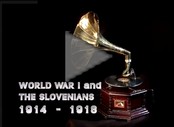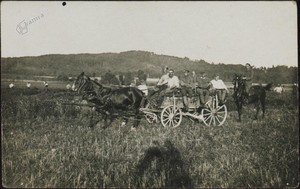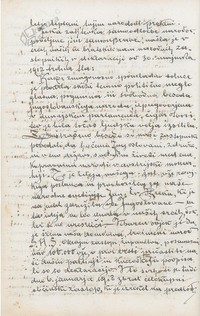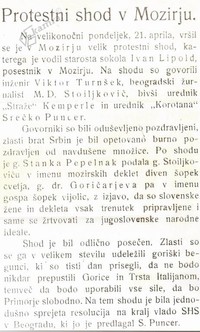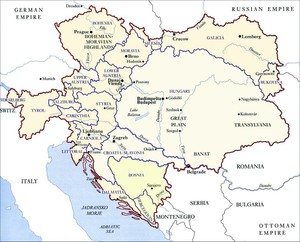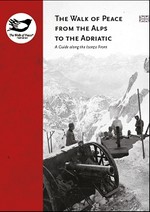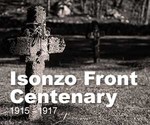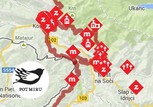Slovenians and the First World War
Slovenian men and women entered the twentieth century as inhabitants of Štajerska, Kranjska, Koroška, Primorska or Istria regions, mainly in peasant attire and on hay carts, although trains had been around for quite a few decades and many Slovenian towns had grown factory chimneys. Still, it was the church rather than the factory clock that counted the hours of most people, and priests, mayors and teachers remained the principal authorities. Slovenians were divided among the Austrian lands, and their regional identity was stronger than their national identity. According to the population census of 1910, 66.6% of the population of today's territory of the Republic of Slovenia were peasants (more than 83% in 1857), livestock and arable farming generated 60% of national income, while only 11% of the population lived on industry and crafts, mostly mining and the iron industry, metal, wood processing and food processing, and construction.
The Austro-Hungarian Empire did not favour Slovenian national demands, in part because the Slovenian territory blocked German access to the Adriatic and the port of Trieste. Nevertheless, the specific multinational environment of the Danubian monarchy, which was slow to catch up with trends in Western Europe, enabled Slovenians to build a national identity, often in severe clashes with Germans. They learnt political culture and became acquainted with parliamentarism. They were mostly literate and knew about developments in their vicinity; they had a mature culture and art that followed European trends and also contributed to them.
The party system and resulting ideological disputes were already a part of everyday life at the beginning of the century. Knowledgeable families subscribed to newspapers – more than a hundred and twenty were published at the turn of the century. Slovenians could even boast scientific breakthroughs, as several notable scientists were active at Austrian and German universities. They did not succeed, however, in their attempt to establish their own university. Slovenians gathered in reading and other societies, at different meetings, climbed mountains and entertained themselves at inns. Progressive intellectuals and politicians believed, in line with the thought prevalent in more developed parts of the world, in continuous and unstoppable scientific progress, which was occurring in Slovenia with the gradual introduction of new technology such as electricity and gas, new means of production and transport and therefore major changes in social structure and the way of life in general. But the Slovenian economy was weak and capital accumulation low. Emigration at the turn of the century led to great demographic loss: more than 250,000 Slovenians emigrated. Severe unemployment was the principal reason, but not the only one. More and more Slovenians who decided to emigrate did so because they wanted a higher standard of living than they could achieve at home.
To put it metaphorically: the turn of the century caught Slovenians halfway between the village and the town in a process of modernisation that had begun, but belatedly.
Strenghtening of the national consciousness
In the early 20th century, national consciousness was related to national enthusiasm and a feeling of severe threat on the one hand, and to the strengthened Yugoslavism that resulted from the annexation of Bosnia and Herzegovina and the ensuing belief that Slovenia’s future lay in integration with other Southern Slavic nations within the Austro-Hungarian borders on the other. “Our national and legal programme is ‘trialism’. We advocate it not only for national reasons, but also for dynastic reasons, because most of the Slovenian people are loyal to the Emperor and strive for a big, mighty monarchy under the sceptre of the Habsburg dynasty...A Yugoslav state in the framework of the monarchy, consisting of Croatia and Slavonia, Bosnia and Herzegovina, the Serbian regions of Hungary, Slovenian and Croatian lands and Cisleithanian regions, especially Dalmatia, Primorska, Kranjska, the Slovenian lands of Štajerska and Koroška, would place the constantly growing Yugoslav national currents at the service of dynastic global politics," wrote Ivan Šušteršič, the leader of the Slovenian People's Party, in a letter to Franz Ferdinand, heir to the throne, on 25 July 1909. Yugoslavism also took different forms: the most radical view was that of the Preporod (renaissance) movement, which supported the idea of a Yugoslav state with a single Yugoslav nation outside Austria, while social democrats advocated ‘transitional’ solutions in the form of various (con)federations. On the eve of war, in 1913, writer Ivan Cankar expressed his faith in a “federal republic of Yugoslavia” uniting Slovenians, Croats, Serbs and Bulgarians, but nevertheless advocated the preservation of Slovenian language and culture. His lecture Slovenians and Yugoslavians held on April 1913 in Ljubljana contained the following words: “Let us leave Austria to wallow in its own muck. Let us be like Mazzini in Italy.” The lecture earned him a week in prison.
If we exclude the politically motivated hostility to Serbia at the beginning of the First World War, we may say that Slovenians certainly fostered positive Southern-Slavic emotions, at least after the Balkan Wars. The leading Slovenian newspapers closely followed developments on the battlefields and expressed their support for Serbia and Bulgaria, especially in the first Balkan War. In the second Balkan War, Slovenian papers took the Bulgarian side and were critical of Serbia; their particular regret was that the former alliance had been broken. On the other hand, they saw Serbia as the actual and moral winner of the Balkan conflict, which only strengthened its reputation and prestige. Liberal politician and the writer Ivan Tavčar made many an effort to strengthen ties with Serbia, pleading with Serbian Prime Minister Nikola Pašić to stop making Serbian politics and make Yugoslav politics instead, which the latter had allegedly promised.
Although Slovenian political and intellectual elites were forced to embrace Yugoslavism as a historical necessity, their understanding of this concept was naïve, with no real knowledge of the cultural and other customs of the Southern Slavic nations; at the same time, it was mainly based on the tendency to form a single Yugoslavian nation because Slovenians could not survive outside it, as an independent nation.
Slovenians and the national question
The First World War affected Slovenians as individuals and as a nation. They died in great numbers on the fronts, as well as in the hinterland, in exile and in internment. The front that ran through Slovenian territory left devastation in its wake. Shortages, hunger, infectious diseases, conscription papers and death notices were the everyday reality of the war. Tens of thousands of inhabitants on both sides of the Isonzo Front were displaced in different camps in Italy, Austria and Hungary. Tens of thousands of Slovenian soldiers were killed for a country that was a bad stepmother, but that they nevertheless defended because they were defending Slovenian territory as part of it, at least on the Isonzo Front. The authorities prosecuted anti-Austrian attitudes, and numerous Slovenian politicians were placed in confinement. Several hundred Slovenians were sentenced to death under martial law. The activities of political parties were limited and controlled; all forms of trade union and workers' movements and all politically ‘unreliable’ organisations were banned. Parliamentary life had died out by 1917. Although the Slovenian parties mostly welcomed the decision of the Austrian authorities to enter the war, German pressure and the difficult situation in the second half of the war gave rise to demands for peace, social and political rights. Slovenian soldiers who had been loyal began to resist.
In the second half of the war, the national question became increasingly prominent. The leading Slovenian politicians believed, almost until the end of the war, that the national question could be resolved within the Austro-Hungarian Empire. On 30 May 1917, after the restoration of parliamentary activity, Anton Korošec, on behalf of the Yugoslav deputy group in the Vienna parliament, demanded a democratic Yugoslav state within the Austro-Hungarian Empire. The national programme, called the May Declaration, initiated a broad national movement, public demonstrations and meetings and the collection of signatures for the declaration.
The Niš Declaration adopted by the Serbian government on 7 December 1914 declared, as a war aim, the liberation and unification of “all our brother Serbs, Croats and Slovenians who are not free”. Although the declaration hinted at the enlargement of Great Serbia to the north, émigré politicians, who were united in the Yugoslav Club, and the Serbian government signed the Corfu Declaration on 20 July 1917, proclaiming the unification of the Serbs, Croats and Slovenians in the same state. It was conceived as a constitutional, democratic state ruled by the Karađorđević dynasty and encompassing all the territory on which the “triple-named Yugoslav nation” lived, which meant the Serbian, Croatian and Slovenian peoples. However, the declaration did not deal with internal arrangement, e.g. the constitution and federal organisation. International circumstances left Slovenians with two extremes: the London Treaty concluded between Italy and the Entente powers on 26 April 1915, which left a quarter of Slovenian territory and almost a third of its population to Italy, and the idealistic points of the American president, Woodrow Wilson of January 1918 that promised the right to autonomous development to nations of the Austro-Hungarian Empire. After the failure of the last attempt of the Imperial Court to save the monarchy, in the manifesto of Emperor Charles of 16 October 1918, Slovenian politicians were left with no alternative but the non-Austrian option. This was symbolised by the words of Anton Korošec, the leading Slovenian politician at the time, uttered at his last audience with Charles on 11 October 1918: “Your highness, it is too late.” The decision was not easy for the political elite. Loyalty to the monarchy was a matter of course for both ordinary people and politicians, especially for the influential clergy. Slavophilia was strong, but there was no help to be expected either from tsarist or revolutionary Russia; in the words of the Russian foreign minister, Sazonov, the country was not willing to fight "half a day more" for Slovenians. The Slavic peoples whose culture and mentality best resembled those of Slovenia were the Czechs and Slovaks, but they had opted for their own state; moreover, they were geographically separated by Austria. The concept of the Southern Slavic nations, especially Serbs, was idealised, but actual knowledge of them was poor. The difference in religions raised doubts. “How hard will it be for us if we are ruled by an Orthodox king after having left a Catholic emperor? Deus misereatur nostri!,”, wrote Prince Bishop Anton Bonaventura Jeglič on 22 November 1918, although he later admitted that he could see no other solution to prevent Slovenians from Germanisation. The firmness and determination of the German stratum towards Slovenians left few options. The same was true for the Hungarians. The Austro-Hungarian Empire was disintegrating regardless of the wishes and influence of Slovenians. The Italian army pressed. Austrian Germans demanded annexation to Germany, which seemed a realistic option at the end of the war. Hungarians never even considered giving up Slovenian territory. Division threatened. Slovenians were part of a defeated country. Serbia was a winner.
The establishment of the State of Slovenians, Croats and Serbs (SHS State)
The State of Slovenians, Croats and Serbs (SHS state) established by Austro-Hungarian Slavs upon the disintegration of the monarchy on 29 October 1918 was a short-term and transitional solution, lasting until 1 December. It stood little chance of survival in the domestic and foreign political situation of the time. It stimulated national emotions, gave Slovenians their first national government and allowed them to demonstrate their sense of political pluralism and organisational skills. Obstacles were soon encountered in the issue of borders. The indecisiveness and lack of initiative of the Slovenian government were remedied by individuals, especially Rudolf Maister, who preserved the north-eastern part of Slovenia, i.e. Maribor and Štajerska. The government of the SHS State (National Council in Zagreb) encountered the question of how to unite with Serbia, especially under pressure from Austro-Hungarian Serbs. Anton Korošec achieved great success at negotiations in Geneva on 9 November 1918, an agreement on federal unification, which, however, remained on paper. After a confused discussion on 23 and 24 November in Zagreb, the National Council accepted the establishment of a united national state with a centralistic arrangement and the Karađorđević dynasty. Yugoslavian state unification was carried out on 1 December 1918 with the proclamation of the heir to the Serbian throne. “Our Austro-Hungarian reality drunkenly rolled under the Karađorđević throne like an empty beer bottle in the garbage,” was the picturesque description of unification by Croatian writer Miroslav Krleža.
Slovenians face a new reality: they live in four countries
Unfavourable foreign political conditions, powerlessness and the awkwardness of Slovenian politicians and the lack of interest of the Serbian or new Yugoslavian authorities meant that Italy got the western part of the Slovenian territory, namely Primorska, while the northern part, Koroška, was lost in a plebiscite. Slovenians faced a new reality: they lived in four countries with different political systems that were all basically authoritarian and unfavourable to Slovenian identity. More than a third of Slovenians remained outside their metropolitan territories, and Slovenia had lost Trieste, where 57,000 Slovenians lived, making it the strongest industrial centre and an outlet to the sea. Between the two world wars, the Slovenians of Primorska were subject to systematic Italianisation, and exposed to fascist violence and economic oppression, which forced about 100,000 of them to emigrate, mostly to Yugoslavia (about 70,000), South America and other parts of the world. Nevertheless, the people of Primorska managed to preserve – either publicly of illegally – their cultural organisations and their cultural identity as Slovenians, and were the first in Europe to physically resist fascism. Slovenians in Austria were formally protected by minority clauses in the Treaty of Saint-Germain-en-Laye, which Austria implemented only partially. After the Anschluss (for which Slovenians voted, too, in order to avoid complaints about disloyalty and the consequences of such classification), Nazi pressure gradually increased. The final objective was to achieve the full deportation and Germanisation of Carinthian Slovenians which the Nazis began during the Second World War, but which failed.
A positive achievement in the national sense after the First World War was the annexation of the easternmost part of the territory, Prekmurje, although the Slovenian national consciousness of the Prekmurje people was weak and adaptation to common life at the time between the two wars (and later) was full of prejudice and stereotypes. In accordance with the Treaty of Trianon, the Raba region remained in Hungary, where Slovenians were subject to Hungarisation on the basis of the theory of their Wendic origin. The poor and backward region managed to preserve the Slovenian language, especially with the help of the Church.
For Slovenians, the manner of accession to the new Yugoslav state was also related to the dilemma of national identity. “The comical or tragic characteristic of Slovenians in Yugoslavia was that they were divided into two nations, Slovenian and Yugoslavian…At first, but not for long, almost everyone was a Yugoslavian, either sincerely or because they were ashamed of their former adherence to Austria, or because of opportunism," was the description of the situation by historian Vasilij Melik. He added that most Slovenians opted for the Slovenian orientation when faced with this division. Translated into political terms, this meant advocating the autonomy that Slovenians never achieved (it was advocated especially in the Catholic camp) or the integral Yugoslavism (which remained the principal characteristic of the liberal camp). Despite the differences and the dissatisfaction with the SHS Kingdom and later the Kingdom of Yugoslavia, Slovenians accepted it as a necessary shield against the German and Italian pressure, and strengthened their culture and economy in its framework.
Dr Božo Repe, Faculty of Arts, Ljubljana
